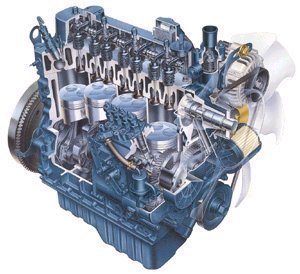|
The transmission charging pump is the
"heart" of any transmission. Before a transmission can do
anything it must have a "pulse" established by mainline
pressure. This mainline pressure is maintained by the pressure
regulating valve from oil flow created by the transmission
charging pump.
The transmission charging pump must be capable of delivering
more oil than the transmission requires, whether at idle or at
high rpm speeds dictated as by engine throttling. The charging
pump is mounted to the transmission and its drive gear is
connected to the torque converter either directly to the hub or
through a gear train. This means that any time the engine is
running, whether the transmission is in gear or not, the torque
converter is turning and the charging pump's drive gear is
rotating. Once you start your engine, transmission oil enters
the pump through the sump intake screen and transmission case
passages. Oil leaving the pump is directed through the case and
oil passages to the pressure regulator valves, the open valve
body passages and the torque converter. Because the pump is
designed to have more capacity than the transmission requires,
it is a pressure regulator valve's job to redirect or "vent" the
excess oil pressure. After oil has filled all open circuits,
mainline pressure increases, building-up on the end of the
pressure regulator valve spool. This pressure buildup reaches a
point where it overcomes an opposing spring force, opening the
regulator valve, causing it to "vent" excess pressure back to
the sump or redirects it to the lube or cooling circuits which
are also individually regulated. This "venting" lowers the
pressure until it is balanced against the opposing regulator
spring force. At this point the mainline pressure is now fully
regulated and will self adjust as system demand changes.
If you're finding metal particles in your transmission fluid
or if your transmission has low mainline pressure, it slips or
just seems extra noisy, then it may be in need of a "heart
transplant". Joseph Industries has an extensive line of
industrial transmission pumps, as well as transmission overhaul
kits that will allow you to perform the "surgery" that your
transmission requires. Contact Joseph Industries about our
current pump specials and quantity breaks. We'll "have
a heart" when you need it the most.
Click Here To View Our Material Handling Application Pump Offerings
Click Here To View
Our Construction Equipment Application Pump Offerings
|
Joseph Industries has over 60 years of engine,
transmission and torque converter remanufacturing excellence for:
-
Material Handling Equipment
-
Construction Equipment
-
Agricultural Equipment
Our offerings include the following
applications:
Joseph Tech Tip:
Anytime you have your engine or torque converter
removed, you owe it to yourself to remove and inspect your
transmission pump and seal. In addition to inspecting the bushings
for wear, you should also completely disassemble the pump and
inspect the pump housing interior and gears for signs of uneven wear
or pitting. The interior surfaces of the pump housing should be
smooth with no scars or gouges and gears should be smooth and
undamaged. When inspecting the pump interior, pay close attention to
the interior surfaces where any metal to metal contact takes place,
such as where the gears ride next to the housing. It is not uncommon
for the internal gears to grind into the pump housing, causing pump
failure. When this happens, metal particles are released into the
fluid system, which can ultimately cause complete transmission
failure.
Product Spotlight!
Joseph Industries now has 4 wheel drive front axle parts and kits
for Case-Carraro backhoe loaders & forklifts! Machine models include
570XLT, 570XLT Series 2, 580L, 580L Series 2, 580SL, 580SL Series 2,
580M, 580M Series 2, 580SM, 580SM Series 2, 585G, 586G and 588G.

Industrial Genuine Parts
Authorized Dealer

Contact us today!
|

